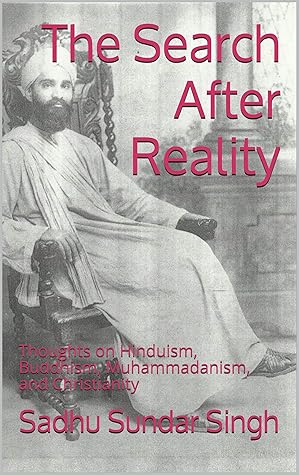The Search After Reality: Thoughts on Hinduism, Buddhism, Muhammadanism, and Christianity
by Sadhu Sundar Singh
Living in close contact with Hinduism, Buddhism, Muhammadanism and Christianity, I have studied their sacred books and the writings of their leading thinkers; while, from personal conversation with many of their learned followers, I have been able to extract much information regarding their faiths. The results of my thinking on these four great religions I have set down in this book. It is not my intention to undertake a systematic and historical review of these religions, but I have sought to set before my readers in thoughts, clothed in simple words, a few of their fundamental principles in the*hope that those who are seekers after the Truth may be helped to know the Ideality. I acknowledge with many thanks my indebtedness to the Rev. T. E. Riddle, of the New Zealand Presbyterian Mission, Kharar, Punjab, for the great help he has given in translating this book into its present form from my Urdu MSS. SUNDAR SINGH. Subathu, Simla Hills, September 1924.
BUY NOW
Kindle Edition
Published February 19th 2021 by Corner Office Books
© 2025 Bibleportal.com 版权所有.

Sadhu Sundar Singh (1889 - 1929)
Was an Indian Christian missionary. He is believed to have died in the foothills of the Himalayas in 1929. Sundar felt that his religious pursuits in Sikhism and the questioning of Christian and Hindu priests left him without ultimate meaning. Sundar resolved to kill himself by throwing himself upon a railroad track. He asked that whosoever is the 'True God' would appear before him, or else he would kill himself; that very night he had a vision of Jesus who opened Sundar's soul to the truth.In October 1906, he set out on his journey as a new Christian, wearing a turban and the yellow robe of a Hindu sadhu, an ascetic devoted to spiritual practice. Singh viewed himself as a sadhu, albeit one within Christianity rather than Hinduism, because he realised Christianity could not penetrate India unless it was in an Indian way. "I am not worthy to follow in the steps of my Lord," he said, "but, like Him, I want no home, no possessions. Like Him I will belong to the road, sharing the suffering of my people, eating with those who will give me shelter, and telling all men of the love of God."
Sadhu Sundar Singh was an Indian Christian missionary. He is believed to have died in the foothills of the Himalayas in 1929.
Searching since boyhood for the way to God, Sundar Singh found truth in Jesus Christ. On his sixteenth birthday, he was publicly baptised as a Christian in the parish church in Simla, a town high in the Himalayan foothills. For some time previously he had been staying at the Christian Leprosy Home at Sabathu, not far from Simla, serving the leprosy patients there. It was to remain one of his most beloved bases and he returned there after his baptism.
At sixteen, the former Sikh became a Christian Sadhu, or holy man, and at great risk devoted his life to Christ. With bare feet and few possessions, Sundar crossed the precarious Himalayas between India and Tibet many times, sharing the gospel with Hindus, Buddhists, Sikhs. As he traveled, Sundar constantly read the Bible, prayed, and meditated, confident that God was always with him, even in the face of death. Preaching in India, Europe, and as far away as America, this Indian saint impacted thousands with his quiet yet bold words and actions.
... Show more